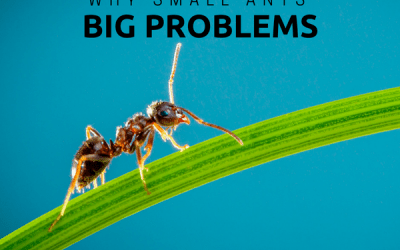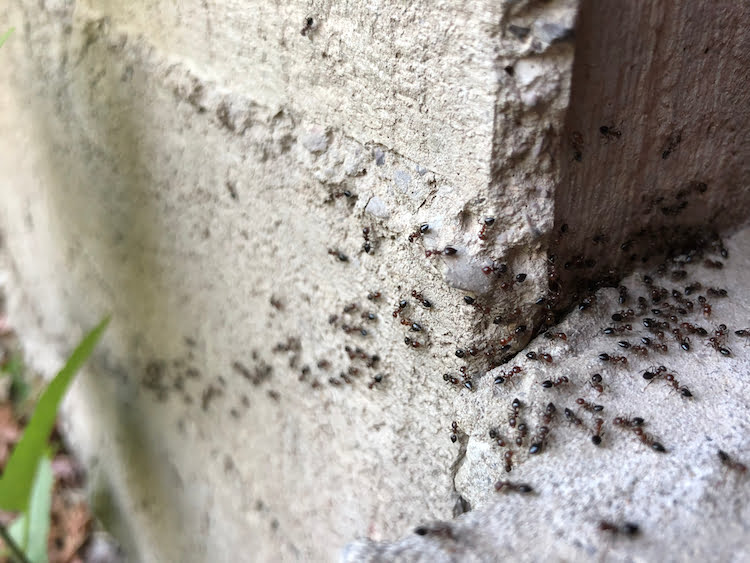Ant problems are often caused by food sources, such as crumbs and spills, as well as entry points like cracks and openings in buildings. These factors attract ants and provide them with access to the space, leading to infestation.
Ants are tiny creatures that can cause significant annoyance when they invade our homes. Understanding the causes of ant problems can help us prevent and manage infestations effectively. By addressing the factors that attract ants, such as food sources and entry points, we can create a less hospitable environment for them.
We will explore the various reasons behind ant problems and offer practical solutions to keep these pests at bay. Let’s delve into the world of ant infestations and discover how to combat them effectively.
Common Causes Of Ant Infestations
Ant infestations can be a frustrating problem to deal with, but understanding the common causes can help you prevent them from happening. By identifying the factors that attract ants and the ways they enter your home or property, you can take proactive measures to keep them at bay.
Food Sources
Bold: Ants are always on the hunt for food, and even the tiniest crumbs can attract them. This is why it is crucial to keep your kitchen and dining areas clean and free of any food debris.
- Seal edible items inside airtight containers to prevent ants from accessing them.
- Regularly clean up spills and crumbs, especially in hard-to-reach areas like under appliances and furniture.
- Dispose of garbage properly and ensure trash cans are tightly sealed.
- Consider using natural ant deterrents, such as vinegar or cinnamon, to discourage ants from approaching potential food sources.
Entry Points
Bold: Ants can find their way into your home through various entry points, taking advantage of even the tiniest gaps or cracks. Understanding these potential entryways can help you block their access.
It is important to regularly inspect your property and seal any possible entry points, such as:
- Cracks in the foundation or walls
- Gaps around windows and doors
- Holes or gaps in screens and vents
- Openings around utility pipes and cables
Bold: Using sealants or caulk to fill these gaps can help prevent ants from entering your home. Additionally, you can place ant barriers or traps near these entryways to intercept any ants attempting to come inside.
Environmental Factors
When it comes to understanding ant problems, environmental factors play a crucial role. These factors can significantly influence the presence and severity of ant infestations. Weather conditions, landscaping, and other environmental elements can create favorable conditions for ants to thrive and infiltrate human living spaces.
Weather Conditions
Weather conditions have a direct impact on ant behavior and population. Warm and humid climates provide ideal conditions for ants to establish colonies and forage for food. Conversely, heavy rains or extreme temperatures may drive ants to seek shelter indoors, increasing the likelihood of entering homes in search of food and protection.
Landscaping
The landscaping surrounding a property can also contribute to ant problems. Overgrown vegetation and mulch near the foundation of a building can create a conducive environment for ants to build nests. Additionally, standing water or poorly managed irrigation can attract ants seeking moisture, providing them with a reliable water source.
Types Of Ants
Ants come in various types, each with specific traits and behaviors. Understanding the different types of ants can help in identifying and addressing ant infestations effectively.
Sugar Ants
Sugar ants, also known as odorous house ants, are attracted to sweet foods and can become a nuisance in homes, especially in the kitchen. They emit a strong, rotten-coconut-like odor when crushed. These ants seek out sugary substances and are commonly found foraging on countertops, around kitchen sinks, and near food storage areas.
Carpenter Ants
Carpenter ants are known for their ability to damage wood. They do not consume wood but excavate it to build nests, which can lead to structural damage in buildings. These ants are commonly found in damp and decaying wood, such as in fences, decks, and tree stumps. Identifying and addressing carpenter ant infestations early is crucial to prevent extensive damage.
Fire Ants
Fire ants are known for their aggressive behavior and painful stings. They build large mounds in open areas such as lawns, parks, and fields. These ants can pose a threat to humans and pets, especially when their nests are disturbed. Fire ant stings can result in painful welts and, in some cases, severe allergic reactions.
:max_bytes(150000):strip_icc()/how-to-get-rid-of-ants-2656468_final-51f2d2e263c1482fa95ec6529a107971.png)
Credit: www.thespruce.com
Impacts Of Ant Infestations
Ant infestations can have various detrimental effects on both your property and your health. These tiny insects may seem harmless individually, but when they gather in large numbers, they can cause significant problems.
Property Damage
Ants can cause damage to your property in several ways:
- Structural Damage: Certain ant species, like carpenter ants, burrow into wood to build nests, causing structural weakening and potential collapse of wooden elements in your home. This activity can lead to costly repairs.
- Electrical Issues: Some ant species are attracted to electrical wiring and can chew on the insulation, exposing the wires and creating fire hazards. This not only poses a risk to your safety but also results in expensive repairs.
- Contaminated Food: When ants invade your kitchen or pantry, they can contaminate your food by leaving behind bacteria and pathogens. Consuming contaminated food can lead to food poisoning and other health issues.
Health Risks
Aside from property damage, ant infestations also pose health risks:
- Bites and Stings: Certain species of ants, like fire ants, deliver painful bites and stings when they feel threatened. Not only can these bites be itchy and uncomfortable, but they can also cause allergic reactions in some individuals.
- Spread of Disease: Ants can carry disease-causing organisms such as bacteria and viruses and contaminate surfaces they crawl on. This increases the risk of illnesses like E. coli, salmonella, and more.
- Asthma and Allergies: Ant-related allergens can trigger asthma attacks and allergic reactions, especially in individuals who are already prone to respiratory issues. This can result in breathing difficulties and other health complications.
Therefore, it is essential to address ant infestations promptly to protect both your property and your well-being.
Prevention Methods
Cleaning regularly eliminates food crumbs attracting ants. Wipe spills promptly avoid leaving sticky residues.
Store food in airtight containers. Dispose of garbage properly prevent ant infestations.
Seal cracks or crevices in walls block ant entryways. Repair damaged screens secure windows and doors.
Use weather stripping barrier small gaps where ants can enter living spaces.
Sprinkle cinnamon or peppermint essential oil near entry points. Plant mint or lavender repel ants naturally.
Vinegar or lemon juice deters ants. Spray these around doorways windowsills.

Credit: ecoclearproducts.com
Diy Ant Control Techniques
Ant problems are caused by food sources, water, and shelter. DIY ant control techniques involve eliminating these factors and using deterrents such as vinegar or essential oils. These methods can effectively prevent and manage ant infestations in your home.
Vinegar Solution Boric Acid BaitAnts can invade our homes and become a nuisance. Using DIY ant control techniques can effectively manage these pesky critters.Vinegar SolutionCreate a vinegar solution with equal parts water and vinegar to repel ants.Boric Acid BaitA mixture of boric acid and sugar can act as a deadly bait for ants.Implementing these methods can help in keeping ants at bay without resorting to harmful chemicals.When To Call Pest Control
Dealing with an ant infestation can be quite a nuisance. While some ant problems can be solved with DIY solutions, there are instances when it becomes necessary to call in the professionals. Understanding the extent of the infestation and recognizing persistent problems are key factors to consider when deciding to seek pest control assistance.
Extent Of Infestation
Assessing the extent of the ant infestation is crucial in determining whether it’s time to bring in the experts. If you notice ants consistently appearing in different areas of your home, even after trying various preventive measures, it may be an indication of a more significant problem. Additionally, if the number of ants has increased significantly or if you’ve noticed ant nests near your property, it’s best to seek professional help.
Persistent Problem
If you’ve been battling ants for a prolonged period with no signs of improvement, it’s smart to consult pest control services. Ants are persistent creatures and can often find ways to bypass DIY treatments. Professional pest control companies have the tools, knowledge, and experience to identify the cause of the persistent ant problem and implement effective solutions. They can also provide long-term prevention strategies to avoid future infestations.
In conclusion, recognizing the extent of the infestation and identifying persistent ant problems are important indicators of when to reach out to pest control professionals. Their expertise can help address the underlying cause and provide effective solutions to rid your home of ants for good.

Credit: www.extension.iastate.edu
Frequently Asked Questions On What Causes Ant Problems
What Are Common Causes Of Ant Problems?
Ant problems are often caused by food crumbs, unsealed containers, or standing water attracting them indoors.
How Can I Prevent Ant Infestations?
To prevent ant infestations, store food in sealed containers, fix any moisture issues, seal cracks, and clean regularly.
Why Do Ants Invade Homes?
Ants invade homes seeking food, water, or shelter. They can enter through small cracks or openings seeking resources.
Are Certain Areas Of The Home More Susceptible To Ants?
Kitchens and bathrooms are common areas for ants due to food and moisture. Regular cleaning and maintenance can deter them.
Conclusion
Ant problems are a common annoyance that can be caused by a variety of factors. By understanding the root causes, such as food sources, moisture, or nesting sites, you can take proactive steps to prevent infestations. Regular cleaning and sealing of entry points can also help to keep ants at bay.
Remember, being proactive is key to minimizing the chances of encountering ant problems in your home or property.

I’m MD Tanvir, and I bring years of expertise gained from working closely with pest control companies to the forefront. My journey in the industry has inspired me to launch Bug Battler, a platform aimed at equipping people with the know-how to combat pests autonomously. Through Bug Battler, I aim to empower individuals with practical insights to tackle pest infestations effectively.

